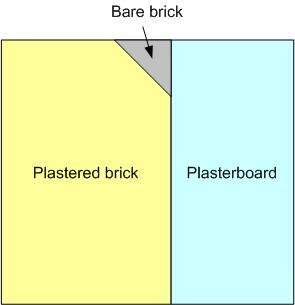Just to recap, then - strip plaster back a foot, fix PB with the front flush against what's left, fill the gap, tape across the join, skim the lot (with multi-finish?), then second skim a couple of hours later.
That’s basically it but you must bond the PB to the brickwork as well as th stud. Use 3 overlapping layers of reinforcing tape over the join. As you will be skimming different materials, give the whole wall (including the PB) a couple of sealer coats of PVA/water (1:5) & let it fully dry out for 24 hours. Give the wall anther PVA coat (1:3/4) when you’re ready to go & plaster when tacky. 2 hours is way too long for the 2nd skim coat & it must go on just as the first starts to firm up. The two coats are best applied from the same mix &, on an average size wall, it should be ready for the 2nd coat more or less as soon as you’ve got the 1st one up there & basically levelled. If your inexperienced, you will really struggle for time so probably 2 mixes will be better for you but timing is very important & you must be quick; if you let the 1st coat go far it’ll defeat the whole point of 2 coats & it'll probably end up looking like a ploughed field.
A few questions on that lot and (hopefully!) I'm ready to go:
- Any tips for removing the plaster section without the whole lot coming off? Just chip away at it with a bolster chisel?
I just use a bolster chisel to mark a line around the opening where I want to remove the plaster; a solid whack will crack the plaster & render underneath, then just remove the plaster from the edge, again using the chisel, & it should crack off at the line but if't loose or sounds hollow you must take it back further until it's solid. Go around the edge of the plaster with a hammer to break it away so it's not a distinct line; the ragged edges provide a good key.
- What to fill the gap with? If the gap is quite small, then would something like expanding foam do the job? Presumably if it's large then I'm looking at filling with bonding/one coat anyway..
Don’t use expanding foam only Bonding plaster.
- Existing plaster wall has been painted - can this just be primed with PVA before skimming or does it have to be stripped first?
If it’s ordinary matt, it should be OK. If it’s vinyl & particularly sheen or gloss, 2 ways to prep;
1. closely criss-cross score the whole wall right through the paint layers with an old scraper or trowel & give it a good going over with a very stiff wire brush before the initial PVA.
or
2. mix up a slurry coat using PVA & some bonding plaster or some cement & brush this onto the wall, once dry it will leave you with a fairly rough surface to plaster over.
Be warned, plastering isn’t as easy as it may look & in most cases your 1st attempt will end on tears! I would advise you at least have a practice session on a sheet of PB before attempting the wall itself.


